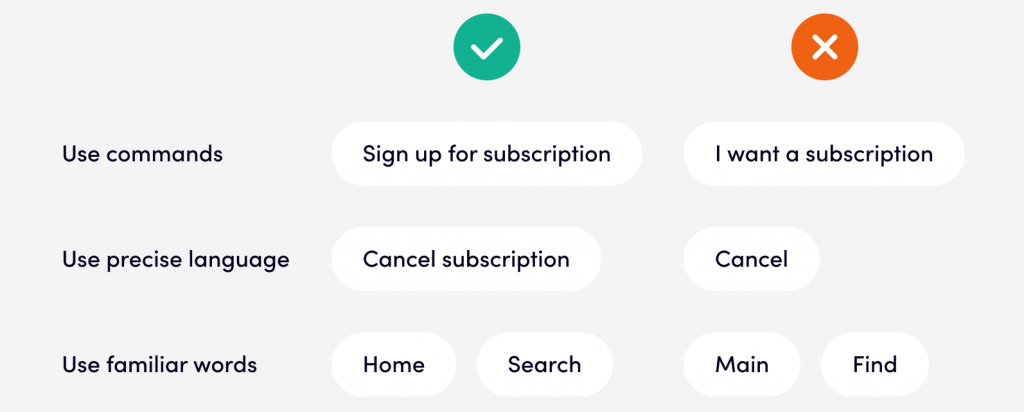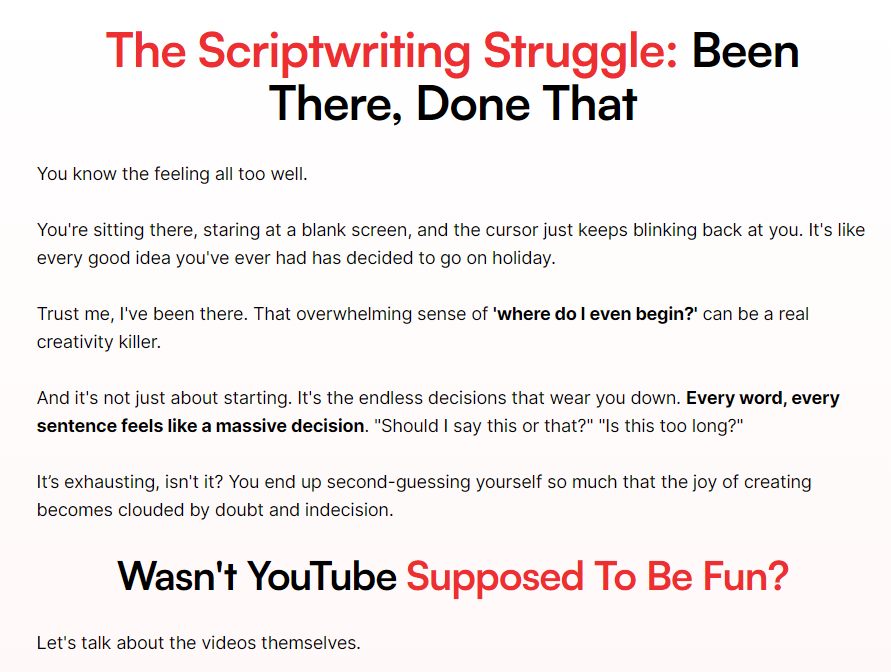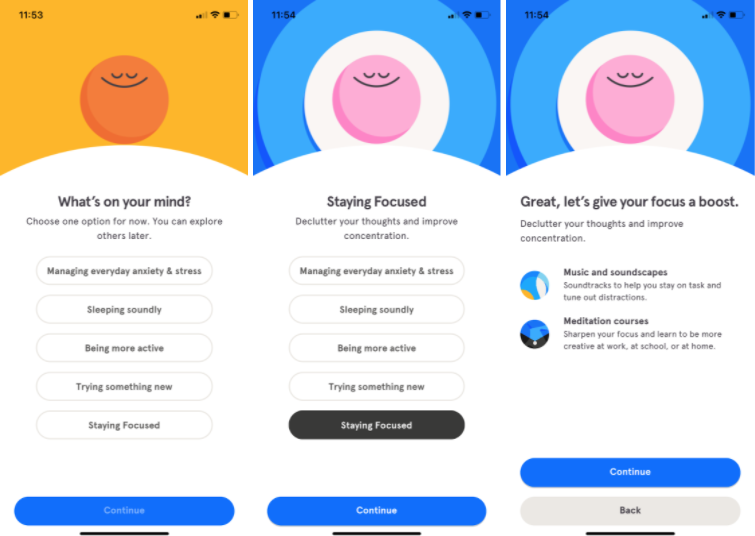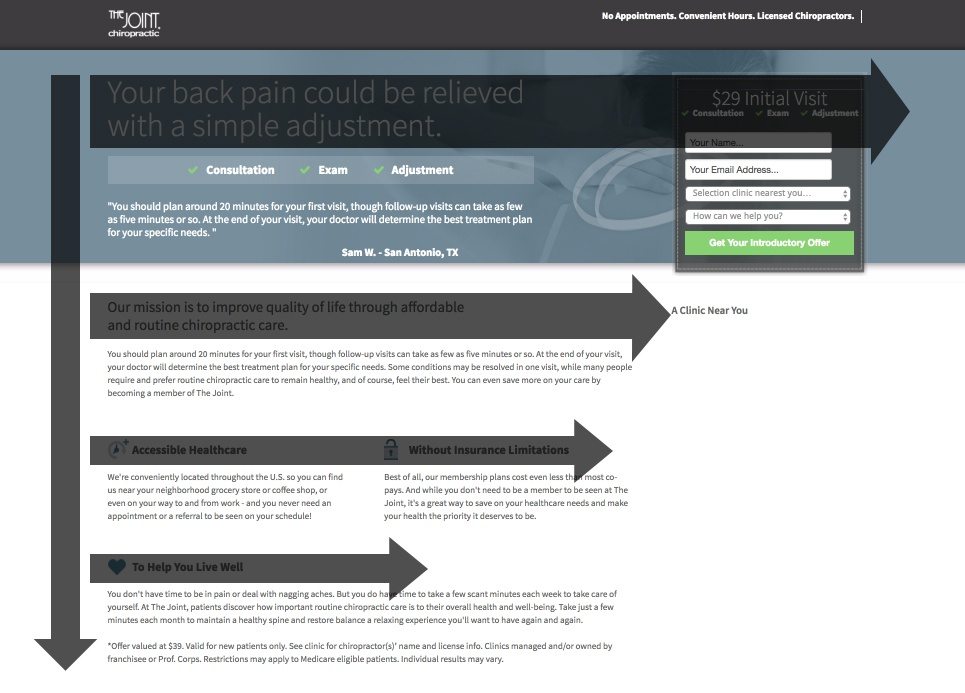Ever found yourself lost in the labyrinth of digital content creation, wondering about the fine line between UX writing and copywriting? You’re not alone. In the bustling world of online interfaces, these two disciplines often intertwine, yet each brings its own flavor to the table. So, let’s see what sets them apart.
This article is your guide to unraveling the mysteries of UX writing and copywriting in a friendly, conversational tone. By the end, you’ll have a clearer picture of how they differ and why it matters in the grand scheme of crafting compelling content for the web. Ready? Let’s dive in.
- UX Writing – What Is It?
- Copywriting – What Is It?
- Copywriting and UX Writing – Differences
- Key Principles of UX Writing
- Key Principles of Copywriting
- How User Reads?
- Why Should Copywriters Apply UX Principles?
- The Importance of UX Writing in Client Retention
- Which One is Suitable for Your Team – UX Writer or Copywriter?
UX Writing – What Is It?

UX writing is the design of content for websites and applications to make them as useful as possible. That is, to enable the user to navigate the site seamlessly and complete the goal—finding information, making a purchase, etc. It can be said to be writing content with user research in mind.
Good UX writing is often “transparent” – providing clear instructions throughout the user journey. We don’t notice it because it is understandable, leaves no room for doubt, and requires no thought on our part.
Flixbus

Here’s an example of a greatly written UX message – 404 error. Instead of using the old-fashioned “page not found”, the UX writer for Flixbus used it to make a CTA out of it. While we hope our users won’t get error messages very often, at least we can make their experience fun once they do.
Also, take a look at booking your destination – everything is clear and concise, leaving no second thought. As you can see, UX writing plays a pivotal role in attracting and retaining users.
Why Is UX Writing So Important?
UX effectiveness is due to a simple reason. As marketing grows, the complexity of websites, platforms, and applications increases. In addition, all companies want to pretend to be professional, taking care of every detail. At some stage, therefore, it is necessary to have a person who will ensure intuitiveness and readability so that users don’t get lost in the plethora of information. 83% of consumers believe that a seamless user experience across all devices is essential.
It is worth noting that, by definition, a UX writer is any writer who creates content with the user in mind. Therefore, a copywriter who creates the simplest texts for a website can be called one. In practice, the duties of a UX writer are often narrowed down to microcopy, that is, to the creation of messages and directions that make it easier to navigate the site.
Benefits of UX Writing
Wondering what actually are the advantages of UX writing? Why should you be interested in it from the business side?
Here are some pluses of UX writing that may convince you:
- A well-done UX design can triple website conversion rates.
- Makes the website more intuitive and user-friendly.
- Helps you gain the trust of your audience.
- In the case of an online store, it helps guide the user through the registration, login, or purchase process.
- Increases the chance of a successful sale.
- Encourages users to take action on the site.
- UX writing minimizes not only the number of words on the page but also technical language and eliminates IT industry jargon. It allows you to reach the user at the consumer level.
Now if you know what are the advantages of ux writing then also read about UX Writing Examples.
Copywriting – What Is It?

Copywriting is the art and science of crafting compelling written content with the intention of persuading an audience to take a specific action, such as making a purchase, signing up for a service, or engaging with a brand. It involves understanding the target audience, identifying their needs and desires, and effectively communicating the value proposition of a product or service in a way that resonates with them.
Copywriters use language strategically to evoke emotion, build trust, and drive desired outcomes, whether it’s through advertising, marketing campaigns, website content, or other mediums. The goal of copywriting is to create engaging and persuasive content that ultimately converts readers into customers or supporters. Here’s an example:
The Youtube’s Scriptwriter’s Playbook

This landing page for a video script writing course is a prime example of effectively addressing your target audience’s pain points to establish trust and rapport. Additionally, the copywriter uses red to highlight the emotional headings, underscoring the reader’s challenges.
As you scroll down, the copywriter presents the concept of proven systems for script writing (the core principle taught in the course) as the solution to these issues. They also include various Twitter threads as evidence to support their claims.
Next, the copywriter outlines the course elements. Instead of merely listing what the course offers, they highlight the specific benefits of each element. For instance, rather than simply stating that the course includes one-on-one coaching calls, they detail specific ways these calls can address common challenges faced by the target audience.
Why Copywriting Is So Important?
Copywriting is crucial for businesses and brands because it serves as the bridge between products or services and potential customers. Effective copywriting has the power to capture attention, convey value, and ultimately drive action. In today’s saturated digital landscape, where consumers are bombarded with information at every turn, compelling copy stands out and cuts through the noise. Writing concise, scannable content can boost a page’s usability by up to 58%.
It has the ability to establish credibility, build trust, and forge an emotional connection with the audience. Whether it’s crafting a catchy slogan, writing persuasive product descriptions, or developing engaging social media posts, copywriting plays a pivotal role in shaping brand perception and influencing purchasing decisions. It’s the language that shapes the narrative of a brand and can ultimately determine its success in a competitive market.
Benefits of Copywriting
These are pretty straightforward since copywriting has been a mandatory aspect of many businesses for years. These are the most important benefits.
- Increases conversion rates by persuading customers to take action
- Establishes brand identity and strengthens brand recognition
- Builds trust and credibility with potential customers
- Enhances engagement and encourages interaction with content
- Improves search engine optimization (SEO) by optimizing written content for keywords
- Helps communicate product features, benefits, and unique selling points effectively
- Supports marketing efforts across various channels, from websites and social media to print materials and advertisements
- Provides a consistent tone and voice for the brand, fostering brand loyalty
- Allows businesses to stand out in a crowded marketplace by crafting compelling messaging
Copywriting and UX Writing – Differences
A copywriter is usually understood as a person who writes texts – advertising slogans, product descriptions for online stores, blog articles, e-books, etc. A UX writer also writes content, but these are texts that support the user as he or she navigates through a website or application.
The main difference between a copywriter and a UX designer is the nature of the content they create. A copywriter writes salesy, persuasive texts, while a UX writer writes informative and functional texts. In addition, the UX writer pays attention to the presentation of the content – the division into short paragraphs, the use of bullets, the alignment of the text to the left, and similar things that greatly impact the comfort of reading the text on the screen.
Copywriters, in their daily work, usually work with marketers and UX writers – with UX designers and developers. In practice, however, it is often the case that both these functions – copywriter and UX writer – are performed by one person.
Here are the main differences between UX writing processes and copywriting.
| Copywriter | UX Writer |
| Content for marketing purposes and advertising. | Content for user interface. |
| Focuses on user demographics, target audiences, and pain points to create compelling content. | Focuses on user’s needs and behaviors when creating an intuitive user interface. |
| Content for advertisements, social media posts, blogs, promo emails, and more. | Microcopy, button labels, error messages, and instructions within the interface. |
| Works with graphic designers and marketing team to create persuasive marketing campaigns. | Works with UX designers to integrate written content with the interface. |
| Promotes more sales, brand awareness, and customer engagement through compelling content. | Aims to enhance user experience, usability, and clarity with the interface. |
Business Marketing vs Customer Help

While both UX writers and copywriters play crucial roles in supporting both customers and the business, they have distinct focuses. UX writing primarily centers on aiding customers in completing tasks and simplifying product use, ultimately boosting customer satisfaction and trust in the brand.
Conversely, copywriting leans more towards driving business profits by crafting enticing and persuasive content that motivates users to take actions that support the company’s marketing goals.
In essence, UX writing prioritizes enhancing the customer experience, while copywriting is geared towards increasing sales and revenue for the business. Both are valuable in their own ways and contribute to overall success when employed effectively within a company’s strategy.
Sales Oriented vs Product Oriented
In essence, copywriting leans towards driving sales, while UX writing is geared towards enhancing the usability and understanding of a product. Copywriting aims to boost business revenue by crafting persuasive content that prompts readers to take action.
On the other hand, UX writers focus on simplifying processes and explanations using straightforward language rather than creating copy to attract potential buyers. Their goal is to improve the user experience by making product usage more intuitive and accessible through their design process.
So, while copywriters strive to impress and persuade readers to support the business, UX writers aim to clarify and streamline the user’s interaction with the product. Both roles are vital in their own right, contributing to the overall success of the company.
Design Tools vs Quantitative Research

Figma and Adobe XD stand out as two popular collaborative design tools frequently utilized by UX writers to communicate effectively with designers.
Figma serves as a versatile platform for crafting interface designs for both web and apps, boasting real-time collaboration capabilities that facilitate seamless teamwork. Similarly, Adobe XD offers UX/UI design functionalities alongside live collaboration features, enabling UX writers to work closely with multiple teams simultaneously.
In contrast, copywriters typically operate independently, relying less on collaborative design tools. Their focus tends to center on leveraging insights gleaned from quantitative research, utilizing creative flair to effectively market digital products.
Thus, while UX writers thrive in collaborative environments aided by tools like Figma and Adobe XD, copywriters often find their creativity sparked by data-driven strategies rather than real-time collaboration.
Technical Writing vs Creative Writing

In the realm of writing, UX writing typically falls within the technical writing niche, while copywriting resides in the realm of creative writing.
For UX writers, it’s essential to possess a grasp of backend technical aspects to effectively translate complex information into simpler terms. This not only aids users in understanding but also enhances comprehension and readability.
Moreover, a UX writer must exhibit insightful and flexible thinking to provide customers with valuable insights into core issues they may encounter.
Conversely, copywriters rely heavily on their creative writing prowess to captivate and engage readers. While they may not delve into technical terminology or backend processes, their primary focus lies in building trust with users and compelling them to support the business through purchases.
In essence, while UX writers navigate technical complexities to simplify information for users, copywriters harness creativity to persuade and inspire action among readers. Both roles are crucial, each requiring a distinct set of skills to effectively communicate with their respective audiences.
Marketing vs User Experience

When discussing writing roles, it’s crucial to distinguish between UX writing, which revolves around User Experience, and copywriting, which is primarily focused on marketing. Marketing entails various strategies aimed at promoting and selling a business’s products or services, including selling, advertising, and product delivery.
On the other hand, User Experience (UX) pertains to the satisfaction and ease of use a person experiences while interacting with a product or service. Therefore, UX copywriting should prioritize enhancing client satisfaction and ensuring a positive user experience by focusing on clear and accessible communication.
Conversely, effective copywriting aims to promote a business’s services and drive sales through compelling and persuasive messaging. In essence, while UX writing centers on optimizing user satisfaction and usability, copywriting is geared towards marketing and sales promotion. Both play vital roles, each with its unique focus within the broader realm of business communication.
Working Alone vs Teamwork
The contrast between UX writers and copywriters is quite distinct. While copywriters typically operate independently, focusing solely on crafting persuasive business copy, UX writers often collaborate closely with UX design teams.
UX writers’ collaboration with the UX design team enhances their understanding of the product content strategy and goals, aligning their writing with the overall product design. This interaction allows for a more cohesive and effective output, as the UX designer’s perspective complements the work of the UX writer.
On the other hand, copywriters have the flexibility to work autonomously, unencumbered by the need to consider product design elements. Their primary objective is to sell the product effectively through compelling copywriting.
While copywriters may occasionally collaborate with marketing or content writing teams to share ideas, their work predominantly revolves around crafting persuasive content independently.
In essence, the collaborative nature of UX writing with the UX design team contrasts with the more solitary approach of copywriting, reflecting the differing objectives and methodologies of each role within the broader context of business communication.
Stories vs Conversions
In the realm of writing, copywriters are known for their storytelling prowess, whereas UX writers excel in facilitating conversations.
The primary focus of a UX writer lies in addressing user problems and providing effective solutions rather than weaving narratives. Introducing storytelling elements into UX writing can potentially undermine the user’s trust in the brand, as it shifts the focus away from problem-solving.
Storytelling is a skill typically associated with copywriting, where the objective is to captivate readers through engaging narratives. While there’s no strict rule against incorporating storytelling into copy, it’s important to prioritize providing solutions to user problems. However, if a UX writer can skillfully integrate storytelling while still addressing user needs, it can indeed enhance the user experience.
Copywriters often leverage storytelling techniques to captivate and impress readers, aiming to leave a lasting impression. Ultimately, while UX writers prioritize facilitating conversations to assist users, copywriters frequently utilize storytelling as a tool to engage and persuade their audience. Both approaches have their merits within the realm of writing and communication.
Key Principles of UX Writing

Implementing the principles of UX writing when creating content in user interfaces allows you to create more useful, understandable, and friendly digital products. There are many principles, and they can vary depending on the context, industry, brand specifics, or individual user needs. Every UX writer should be flexible in his or her work and adapt to different situations and challenges.
Here are the essential UX writing tips:
Empathy
Understanding users’ needs, expectations, and context is key, as content should provide them with valuable information. For this purpose, a sales persona is often defined.
The UX writer should try to anticipate users’ questions and needs, providing answers at appropriate points in the interface. The content should relate to the actions users are expected to perform. The message should be action-oriented, emphasizing the benefits of taking certain steps.
The UX writer should create content that is “gracious” to users, even if they make a mistake. Error messages, warnings, or tips should be helpful, understandable, and unblaming.
Understandability
Texts should be written in a way that is simple and understandable to users. Complex phrases or technical jargon should be avoided. Content should help users quickly understand the functions and navigation of a digital product. If the content is difficult to understand, the UX writer should use examples and analogies to make the information easier to digest.
The shorter and more precise the texts, the better. Limiting the length makes it easier for users to assimilate the information, so the content should convey the essence of the message in as concise a form as possible.
Consistency
Maintaining a consistent tone, style, and terminology is important for creating a friendly and professional brand image. It also helps users understand and remember key information.
Accessibility
Texts should be accessible to a wide range of audiences, including people with disabilities. This means using legible fonts, bright contrasts, appropriate hierarchy of information, and avoiding ambiguity.
Accessibility also means appropriate language. Using the active form rather than the passive form makes content more direct, engaging, clear, and easy to understand. The UX writer should also consider that users will differ, often significantly. For this reason, they should use clear but neutral language. Texts written in the second person singular (e.g., “click the button”) will reach everyone.
If it is necessary to refer to a specific person, the use of the singular may be a good solution – instead of writing “manager” or “manager,” one can write “manager/managerial person.” Inclusiveness of content can improve the perception of your brand.
Read also about UX Writing Best Practices.
Key Principles of Copywriting

Copywriters need to attract readers with thoughtful, compelling content. By writing blog posts, advertisements, promo emails, etc., they aim to drive more sales, brand awareness, and customer engagement. To stay effective, copywriters also need to follow specific principles. Here are the most important ones.
Writing Skills
Copywriters, like UX writers, need to be skilled at writing, including using correct grammar, punctuation, and spelling. They also need to create content that grabs people’s attention and educates them.
Getting to Different Target Audiences
Copywriters must possess an in-depth comprehension of their target audience to effectively tailor their tone and style to resonate with them, thereby accomplishing the intended outcomes.
Research
Copywriters often cover a wide range of topics. Therefore, they need to do proper research, including technical areas that may be relevant to readers and potential clients.
Attention to Detail
Content isn’t everything. The provided copy should be consistent, accurate, and free of stylistic and grammar errors.
Creativity
Copywriters often compete to stand out in a crowded marketplace. This means they have to come up with new ideas and concepts to rise in the SERPs.
Communication
Copywriters need to collaborate with clients, team members, and other stakeholders. This means accepting constructive criticism and responding to feedback from either of them.
Time Management
Copywriters work on multiple projects at the same time, often with strict deadlines. Therefore, time and energy management are crucial to deliver everything on time.
Marketing and Advertising Knowledge
Understanding marketing and advertising principles, market trends, and consumer behavior is a must. Only then copywriters will create content that meets business objectives.
Proper Design
A good copy should fit into visual layouts of websites they’re writing for.
Flexibility
Different topics require different approaches. Formal, conversational, informative – it all depends on the client’s needs. A good copywriter will adjust the writing style to deliver high-quality content that meets the brief.
How User Reads?

It has long been known that the way we read printed texts is significantly different from the way we get acquainted with digital ones. An online user typically scans a text with their eyes and rarely reads it from cover to cover. A study by Jacob Nielsen (one of the leading researchers and UX specialists) as early as 2006 proved that Internet users read online publications in an F-shaped pattern. This means that they read the first sentence of a paragraph carefully, and with each subsequent sentence, they shorten it only to the beginning.
Knowing these practices will allow you to design your content more effectively and focus on getting the audience to read the key points of an article.
Why Should Copywriters Apply UX Principles?
Many of the principles of UX writing are duplicated in copywriting practices. Nevertheless, every copywriter should remember to implement them in their daily work. This way you can be sure that the content will be usable, clear, and, above all, encouraging to read and perform a specific action. A creative, but also functional marketing message is likely to enjoy greater audience engagement and build a group of loyal customers.
UX writing allows you to create specialized text that is also user-friendly. It is worth remembering to design content and use clear, direct phrases. Such practices work well in the communication of many brands, regardless of the industry.
The Importance of UX Writing in Client Retention

UX writing is hugely important in customer retention. After all, Internet users are spoiled for choice these days. Therefore, if the texts on a website are not created with their convenience in mind and are not intuitive, they will leave it without hesitation.
Today’s market competition is no longer just about price or product. It is based on the ability to trace and design the viewer’s experience on the site. Hence, the growing need for new specialists, including UX writers.
You may be thinking right now that your company needs new employees. Remember, however, that you can outsource to a marketing agency like GamerSEO to comprehensively manage your site in whatever area you want – SEO, UX, or even SXO.
Which One is Suitable for Your Team – UX Writer or Copywriter?
While both positions demand top-notch writing abilities, UX writing and copywriting serve distinct purposes within design teams.
Opting for a UX writer is logical if your team requires assistance with crafting copy that directs users within the product’s interface. Conversely, a copywriter may be necessary if you’re seeking promotional or persuasive content.
Both roles play critical parts in a product’s success, and selecting the ideal match for your team hinges on your business requirements and goals.

A dedicated copywriter with over 3 years of experience behind him. He loves writing about SEO, video games, and the ever-evolving world of NFTs. Passionate about content that performs (and preferably ranks on page one), while habitually overthinking meta descriptions. When he’s not at the keyboard, you’ll find him deep in a story-driven game or somewhere lost (on purpose) in the mountains—preferably without cell signal.

